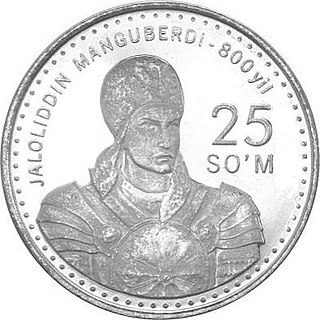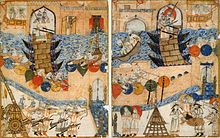The Kara-Khanid Khanate, also known as the Karakhanids, Qarakhanids, Ilek Khanids or the Afrasiabids, was a Karluk Turkic khanate that ruled Central Asia in the 9th through the early 13th century. The dynastic names of Karakhanids and Ilek Khanids refer to royal titles with Kara Khagan being the most important Turkic title up until the end of the dynasty.

The Anushtegin dynasty or Anushteginids, also known as the Khwarazmian dynasty was a Persianate Sunni Muslim dynasty of Turkic mamluk origin from the Bekdili clan of the Oghuz Turks. The Anushteginid dynasty ruled the Khwarazmian Empire, consisting in large parts of present-day Central Asia, Afghanistan and Iran in the approximate period of 1077 to 1231, first as vassals of the Seljuks and the Qara Khitai, and later as independent rulers, up until the Mongol conquest of the Khwarazmian Empire in the 13th century.

'Alā' al-Din Muhammad was the Shah of the Khwarazmian Empire from 1200 to 1220. His ancestor was Anushtegin Gharchai, a Turkic Ghulam who eventually became a viceroy of a small province named Khwarizm. He incited the Mongol conquest of the Khwarazmian Empire, which resulted in the utter destruction of his empire.
The Battle of Parwan was fought between Sultan Jalal ad-Din Mingburnu of the Khwarazmian Empire and the Mongols ruled by Genghis Khan in September 1221 AD at Parwan, north of Kabul, in present-day Afghanistan. Jalal ad-Din had previously attacked a detachment of Mongols near Wilan, which provoked Genghis Khan into sending an army of 30,000 troops under Shigi Qutuqu. As a result of the tactics adopted by Jalal ad-Din, the Mongol army was destroyed in a two-day battle. As news of the Mongol defeat spread, several cities, including Merv and Herat, which had previously surrendered and accepted Mongol rule, rebelled. In response, Genghis Khan moved to battle Jalal ad-Din, who had lost half of his troops to desertion due to a quarrel over the division of spoils after the battle, and was forced to move to Ghazni to prepare to retreat to India. Genghis Khan intercepted Jalal ad-Din's army as he was preparing to cross the Indus River, and in the ensuing battle he lost his army, treasury and family, but survived to eventually establish a power base in Punjab and Sindh.

Chagatai Khan was the second son of Genghis Khan and Börte. He inherited most of what are now five Central Asian states after the death of his father. He was also appointed by Genghis Khan to oversee the execution of the Yassa, the written code of law created by Genghis Khan.
Mongol ruler Ghazan Khan converted to Islam.
Khwarazmshah was an ancient title used regularly by the rulers of the Central Asian region of Khwarazm starting from the Late Antiquity until the advent of the Mongols in the early 13th-century, after which it was used infrequently. There were a total of four families who ruled as Khwarazmshahs—the Afrighids (305–995), Ma'munids (995–1017), the line of Altuntash (1017–1041), and the most prominent ones, the Anushteginids (1097–1231). Like other contemporary Central Asian titles, such as Afshin and Ikhshid, the title of Khwarazmshah is of Iranian origin.
Kuchlug was a member of the Naiman tribe who became the last emperor of the Western Liao dynasty. The Naimans were defeated by Genghis Khan and he fled westward to the Qara Khitai, where he became an advisor to his future father-in-law Yelü Zhilugu. He later rebelled, usurped the throne and took control of the empire, putting an end to the rule of the House of Yelü. He was killed in 1218 by the Mongols and the domain of the Qara Khitai was absorbed into the Mongol Empire.
The Mongol invasion of Khwarazmia took place between 1219 and 1221, as troops of the Mongol Empire under Genghis Khan invaded the lands of the Khwarazmian Empire in Central Asia. The campaign, which followed the annexation of the Qara Khitai Khanate, saw widespread devastation and atrocities. The invasion marked the completion of the Mongol conquest of Central Asia, and began the Mongol conquest of Persia.
The Mongol invasion of Central Asia occurred after the unification of the Mongol and Turkic tribes on the Mongolian plateau in 1206. Smaller military operations of the Mongol Empire in Central Asia included the destruction of surviving Merkit and Naimans and the conquest of Qara Khitai. These were followed by a major campaign against Khwarazm. Expansion into Central Asia began in 1209 as Genghis Khan sent an expedition to pursue rivals who had fled to the region and threatened his new empire. The Uyghur kingdom Qocho and leaders of the Karluks submitted voluntarily to the Mongol Empire and married into the imperial family. By 1218 the Mongols controlled all of Xinjiang and by 1221 all the territories of the former Khwarazmian Empire. In 1236, the Mongols defeated the eastern portions of Cumania and swept into Eastern Europe.

Jalal al-Din Mangburni, also known as Jalal al-Din Khwarazmshah, was the last Khwarazmshah of the Anushteginid dynasty. The eldest son and successor of Ala ad-Din Muhammad II of the Khwarazmian Empire, Jalal al-Din was brought up at Gurganj, the wealthy capital of the Khwarazmid homeland. An able general, he served as second-in-command to his father in at least one battle; however, since he was the son of a concubine, he was challenged as successor by a younger brother, whose cause was supported by the powerful Queen Mother, Terken Khatun. Nevertheless, after the Mongol conquest of the Khwarazmian Empire led to his father's flight and death on an island in the Caspian Sea, Jalal-al Din gained the loyalty of the majority of Khwarazmian loyalists.
The Khwarazmian or Khwarezmian Empire was a culturally Persianate, Sunni Muslim empire of Turkic mamluk origin. Khwarazmians ruled large parts of present-day Central Asia, Afghanistan, and Iran in the approximate period of 1077 to 1231, first as vassals of the Seljuk Empire and the Qara Khitai, and from circa 1190 as independent rulers, up until the Mongol conquest in 1219–1221.

The Mongol conquest of Khorasan took place in 1220-21, during the Mongol conquest of the Khwarazmian Empire. As the Khwarazmian Empire disintegrated after the capture of the large cities of Samarkand and Bukhara by the Mongol Empire, Shah Muhammad II fled westwards in the hope of gathering an army. Genghis Khan ordered two of his foremost generals, Subutai and Jebe, to follow the Shah and prevent any such Khwarazmian resurgence; meanwhile, he sent his youngest son Tolui south to subjugate any resistance.

The Mongol Empire conquered the Qara Khitai in the year 1218 AD. Prior to the invasion, war with the Khwarazmian Empire and the usurpation of power by the Naiman prince Kuchlug had weakened the Qara Khitai. When Kuchlug besieged Almaliq, a city belonging to the Karluks, vassals of the Mongol Empire, and killed their ruler Ozar, who was a grandson-in-law to Genghis Khan, Genghis Khan dispatched a force under command of Jebe and Barchuk to pursue Kuchlug. After his force of 30,000 was defeated by Jebe at the Khitan capital Balasagun, Kuchlug faced rebellions over his unpopular rule, forcing him to flee to modern Afghanistan, where he was captured by hunters in 1218. The hunters turned Kuchlug over to the Mongols, who beheaded him. Upon defeating the Qara Khitai, the Mongols now had a direct border with the Khwarazmian Empire, which they would soon invade in 1219.

Terken Khatun was the Empress of the Khwarazmian Empire by marriage to Shah Ala al-Din Tekish, and the mother and de facto co-ruler of Muhammad II of the Khwarazmian Empire.
Yelü Zhilugu was the third emperor of the Western Liao dynasty, ruling from 1177 to 1211. As the final ruler from the House of Yelü, he is considered by traditional Chinese sources to be the last monarch of the Western Liao dynasty.
The Irghiz River skirmish was a minor engagement fought between forces of the Khwarazmian Empire and the Mongol Empire during the early 13th century. While the occurrence of the skirmish itself is well-attested, its precise dating is uncertain, since the major chroniclers of the period give differing accounts. Modern historians have proposed two possible dates: 1209 or 1219. The background events are similar for each possible date: Genghis Khan, khagan of the Mongols, sent an army under his general Subutai to attack hostile forces in the former lands of the Qara-Khitai dynasty. Shah Muhammad, the ruler of the Khwarazmian Empire, received news of large armies operating along his northern borders and set out to confront them.
The siege of Bukhara took place in February 1220, during the Mongol conquest of the Khwarazmian Empire. Genghis Khan, ruler of the Mongol Empire, had launched a multi-pronged assault on the Khwarazmian Empire ruled by Shah Muhammad II. While the Shah planned to defend his major cities individually, the Mongols laid siege to the border town of Otrar and struck further into Khwarazmia.
The siege of Samarkand (1220) took place in 1220 A.D. after Genghis Khan, founder of the Mongol Empire, had launched a multi-pronged invasion of the Khwarazmian Empire, ruled by Shah Muhammad II. The Mongols had laid siege to the border town of Otrar, but finding its defences obdurate, a large force commanded by Genghis and his youngest son Tolui detached from the vanguard and set off southwards, towards Transoxiana.

The Otrar Catastrophe was a siege that took place between December 1219 and February 1220 during the Mongol conquest of the Khwarazmian Empire at Otrar, a large trading city on the Syr Darya river. Inalchuq, the city's governor, had seized the goods of a Mongol trade caravan the previous year; after more provocations from Inalchuq's liege and ruler of the Khwarazmian Empire, Shah Muhammad II, Genghis Khan launched a full-scale invasion of the empire.









